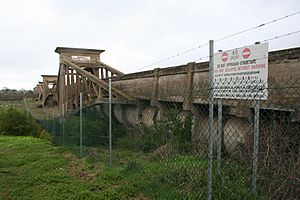Barwon Sewer Aqueduct facts for kids
Quick facts for kids Barwon Sewer Aqueduct |
|
|---|---|

Northern end of the Barwon Sewer Aqueduct in 2007
|
|
| Crosses | Barwon River |
| Locale | Goat Island, Breakwater, Victoria, Australia |
| Named for | Barwon River |
| Characteristics | |
| Total length | 750m |
| Height | 176 feet |
| Number of spans | 14 |
| History | |
| Designer | E. G. Stone |
| Construction begin | 1913 |
| Construction end | 1915 |
| Construction cost | £18,450 |
The Barwon Sewer Aqueduct is a special bridge-like structure in Breakwater, Victoria, Australia. It was built a long time ago, between 1913 and 1915, to carry a large sewer pipe across the Barwon River. It's unique because of its length and the way it was built using a special concrete technique called the Considere system. This aqueduct is considered an important historical site in Victoria. It was added to the Victorian Heritage Register in 1991.
Contents
What is the Barwon Sewer Aqueduct?
The Barwon Sewer Aqueduct stretches across the Barwon River flood plain near Geelong. It's known as one of the longest structures built using the Considere system, a special way to strengthen concrete.
How is the Aqueduct Designed?
The aqueduct is about 750 meters (2,424 feet) long and has 14 sections, called spans. Each section is supported by strong pillars. These pillars hold up a concrete pipe that carries the sewer and a walkway for people to use. The design is very practical, but the pillars also have simple, decorative shapes that look like ancient Egyptian or Classical arches.
Why is its Design Special?
This aqueduct is one of the last examples in Australia that used Armand Considere's special method for reinforcing concrete. This method made concrete structures very strong and durable. Many early concrete bridges, like this one, were built to be very sturdy and simple, much like older wooden bridges.
Why was the Aqueduct Built?
In the early 1900s, cities like Geelong were growing fast. This meant they needed better ways to manage their waste, including new sewerage systems.
Planning Geelong's Sewerage System
To solve the problem, the Geelong Commissioners, who were in charge of the city's development, looked at how other cities like Sydney and Melbourne handled their sewage. They decided that Geelong needed its own modern sewerage system.
Mr. R. T. Mackay, the Chief Engineer for the Geelong Waterworks and Sewerage Trust, played a key role. He realized that simply putting sewage into the Barwon River wouldn't work because the river didn't flow fast enough to clean it properly. After studying different options, including sending treated sewage into the ocean, he recommended building an ocean outfall system.
Building the Aqueduct
The Barwon Sewer Aqueduct was a very important part of this new sewerage system. It was designed in 1912 by an engineer named E. G. Stone. Construction began in 1913 and finished in 1915. The cost was about £18,450, which was a lot of money back then!
Mr. Stone's company, Stone and Siddeley, won the contract to design and build the aqueduct. They also made the concrete pipes for the sewer system right there in Geelong.
How the Aqueduct was Constructed
The aqueduct was built using a "cantilever" design. This means that parts of the bridge extend out like arms from the main supports. This design helped the aqueduct handle changes in temperature without cracking.
The sewer pipes themselves were made of pre-cast concrete and shaped like an oval to help the water flow efficiently. These pipes were built right into the structure of the aqueduct. Strong concrete piles were used to support the bases of the pillars, even though rock was found deep underground.
The aqueduct also included a footpath along its entire length. When it was finished, it was considered one of the best concrete structures in Australia.
What is the Aqueduct's Current State?
The Barwon Sewer Aqueduct was used from 1916 until 1972. After it was no longer used, it was recognized as a historic building in 1981.
Repairs and Preservation Efforts
Over the years, the aqueduct has needed repairs. Between 1977 and 1980, workers used a special concrete spray called shotcrete to cover parts where the reinforcing steel was showing. This damage happened because of fumes and a process called carbonation, which affects concrete over time.
In 1995, a report suggested that the aqueduct was in poor condition. However, other engineers disagreed, and an inquiry in 1996 decided that the aqueduct should not be torn down. Today, groups like the Geelong Aqueduct Committee want to see the aqueduct restored. Its owners, Barwon Water, have estimated that it would cost a lot of money to repair and maintain it for the future.

